

 The South African
The South African
The sinking of the Birkenhead remains one of the greatest maritime disasters in South Africa's history. But what it is chiefly remembered for is that every one of the seven women and thirteen children aboard survived the wreck owing to the gallantry and discipline of the men on board. The soldiers of the British Army regiments, and the sailors and marines under Captain Robert Salmond, jeopardised their own chances of survival by putting the 'women and children first' in a gesture immortalised by Rudyard Kipling as 'Birkenhead Drill'.
The 150th anniversary of this historical event was commemorated with appropriate ceremony on Tuesday, 26 February 2002, and the days preceding. The numerous sites included Simon's Town Garden of Remembrance; Gansbaai, where many of the survivors came ashore, and some of the dead are now buried; and Danger Point, marked by a lighthouse since 1895.
The story of the Birkenhead begins at the Port of Cork in Ireland in January 1852. There she embarked 479 soldiers from a variety of regiments who were bound for the Eastern Cape to reinforce the British troops fighting in the 8th Frontier War. A number of military and naval officers, more than fifty women and children, and a crew of 125 brought the ship's complement to about 693. All these were crammed into an iron hull less than 64 metres long and a little more than eleven metres wide - about the width of a tennis court.
The ship displaced 1918 tons, and was built at the town from which she derived her name. Originally designed as a frigate, HMS Vulcan, for the Royal Navy, she was converted into a troopship in 1850. She was one of the first of her kind to be built of iron, which tended to be brittle. Iron plates tear easily, which could help to explain why the ship took water so rapidly. The Birkenhead was among the early attempts to marry sail and steam. Rigged as a brigantine, now with a third mast, her alternative power came from two single-piston engines that developed a combined 350 horsepower. These turned paddle wheels on either side of the hull. She was travelling on her engines when she struck.
The voyage from Ireland had been a particularly rough one. The ship sailed into a terrible storm immediately on leaving port, a fact which points to the urgency of the voyage. No sailing ship would have ventured into such weather. The Birkenhead was in a hurry. The reinforcements she carried were wanted urgently, and her 47-day passage to Simon's Town set a record for the time.
Passenger-carrying capacity was limited by the fact that much of the space below decks was taken up by the engines and coal bunkers. Thus, there were many tales of hardships and discomfort by the time the ship reached Simon's Town on 23 February 1852. Three women had died on the voyage, and four children were born.
Two days were spent at Simon's Town, during which some of the passengers, including a number of women and children, were disembarked. Fuel, victuals, additional passengers and nine horses, plus their forage, were taken aboard. The ship left for Algoa Bay at 18.00 on 25 February. In contrast to the weather endured on the first leg of the voyage, the conditions that evening could not have been better. Visibility was excellent and the sea flat and calm, facts which, strangely enough contributed to the disaster.
Course was set to give the treacherous Agulhas Coast a reasonable berth, although there may have been a couple of small errors in the compasses, and a strong south-east current sweeping into Walker Bay could have carried the ship closer to land than intended. Whatever the circumstances, it was only a few hours later, with Danger Point abeam, that the Birkenhead's iron hull was ripped open on the uncharted spur of rock which now bears her name. Despite the good visibility, the lookouts had seen nothing because the sea was calm and there had been no breaking surf or white water to warn of danger.
Many of the men asleep in the bowels of the ship were drowned by the first inrush of sea water. The rest took part in a the mad scramble for the deck. Awakened by the impact, the captain immediately ordered the engines stopped and the boats launched, although only three of the eight boats the ship was carrying could be set afloat.
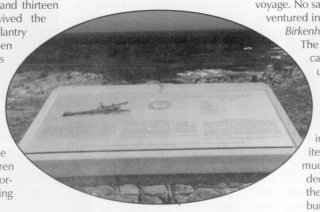
The Birkenhead Memorial after its unveiling,
31 March 1995. The groove, top centre, points to
the rock. (Photo: Antony Gordon)
In those days, there was no such thing as 'boat drill' as exists today on passenger ships, and what boats were available were in grave danger of being swamped by panic-stricken men desperate to survive. This might well have happened if the senior army officer on board, Lieutenant-Colonel Seton, had not instructed his officers to establish order among the men. Discipline was soon restored, and the women and children boarded the boats unhindered.
At this point Captain Salmond took a fateful decision. Seriously concerned that the remaining boats could not be launched before his ship sank, he ordered the engines in reverse in an attempt to back off the rock. The Birkenhead broke free, only to strike again. The bows broke away and began to sink. The soldiers were ordered to the stern, and not to go overboard for fear of swamping the boats. There, in serried ranks, they watched the three boats carrying the women and children pull away.
Few of the men could swim, even the sailors, who traditionally regarded an ability to swim as being unlucky. There were no lifebelts, except only one, privately owned. It was the property of Cornet Bond of the 12th Lancers. He made his way ashore to find his horse waiting for him.
When the stern sank only 20 minutes after the ship had first struck, those who could took to the water. About 80 found places in the boats. Some men climbed the main top mast. Others struck out for the shore nearly two kilometres away. Only 68 men, most of them clinging to pieces of wreckage, survived the swim through the icy water, the hungry sharks and the clinging kelp.
Two of the boats were picked up by the schooner Lioness, which went on to the wreck site and rescued about 40 men still clinging to the rig. The Ship's gig made for Hangklip and landed near what is now Fisherhaven. There the local fishermen provided food and shelter, and a horse for the ship's surgeon to ride the 60km to Cape Town to break the news. The boat he left as security for the horse was still in use nearly 100 years later.
Ashore, the survivors trudged through Strandveld on the eastern shore of Walker Bay to find initial shelter at Stanford's Cove. Eventually they gathered at Kleine Rivier, near Stanford, the farm owned by ex-Dragoon Guard, Capt Smales. A few other survivors were found, including men who had spent 38 hours in the water, but searches of the rocks and beaches found mostly the dead, some tied to wreckage, many mutilated by sharks. They were buried in shallow graves where they were found.
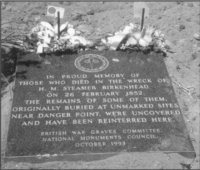
The Birkenhead graves, Simon's Town
Naval Garden of Remembrance.
(Photo: By courtesy, Antony Gordon).
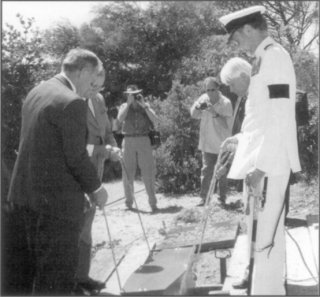
The burial of the remains of five victims of the
Birkenhead disaster at Simon's Town Naval
Garden of Remembrance, 21 February 2002.
Pall bearers are (from left) G Hoult; M Leach;
Maj I Donnelly; and Cdr W M Bisset, South
African Navy. (Photo: By courtesy, A Gordon).
The sinking of the Birkenhead was a maritime disaster of the first order. It also provided a wake-up call on the vital subject of safety at sea. But what it is chiefly remembered for, and for which it has since been commemorated, was the brave sacrifice of the troops who stood fast on deck as the ship sank in order to allow the women and children to make their way to safety. It remains one of the proudest moments in Britain's naval and military history. The call, 'Women and Children First', is now common on the scene of disasters the world over.
| Numbers of survivors and perished in the Birkenhead | |||
|---|---|---|---|
| Regiment | Perished | Survived | TOTAL |
| The Royal Navy | 65 | 53 | 118 |
| The Royal Marines | 14 | 6 | 20 |
| 12th Lancers | 5 | 3 | 8 |
| 2nd Regiment | 36 | 18 | 54 |
| 6th Regiment | 48 | 14 | 62 |
| 12th Regiment | 55 | 16 | 71 |
| 43rd Light Infantry | 27 | 14 | 41 |
| 60th Rifles | 30 | 11 | 41 |
| 45th Regiment | 3 | 1 | 4 |
| 73rd Highlanders | 56 | 18 | 74 |
| 74th Highlanders | 50 | 14 | 64 |
| 91st Highlanders | 45 | 17 | 62 |
| Army surgeons | 2 | 1 | 3 |
| Women | 0 | 7 | 7 |
| Children | 0 | 13 | 13 |
| Civilian servant | 1 | 0 | 1 | TOTAL | 437 | 206 | 643 |
Figures include officers and men. (Adapted from D Bevan, Stand Fast, p 178).
Planning for the commemoration of the sinking of the Birkenhead started nearly a year before the event. The Gansbaai Tourism Committee under Colonel Alec Kitley, late of the SAAF, began the process. It was later joined by Major Antony Gordon, who helped with the military contacts, especially with those from the UK. From the outset, the intention was to involve the local community, all the British services and the ten regiments involved, as well as the official authorities. The South African local authorities, the tourism departments and the armed services, were also to be involved.
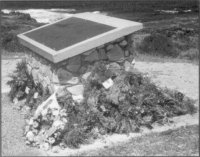
Birkenhead Memorial, Danger Point,
after the wreaths (mostly of local fynbos)
had been laid by 25 services,
26 February 2002. (Photo: A Gordon).
It was planned to have a wreath for every one of the victims, each bearing his name, made by local children. All these events were co-ordinated so as to gain as much publicity as possible for the town of Gansbaai and its surrounding area.
The first event was held on Thursday, 21 February 2002, at Simon's Town Garden of Remembrance. A burial service was held for the remains of five victims of the wreck found at Danger Point. The following day, at Danger Point Lighthouse, wreaths bearing individual labels giving name, rank and regiment were laid out by reginients and services. Some of the children who had made the wreaths also attended. All regimental guests and services were invited, including Sarah Drury, great granddaughter of the Birkenhead's captain, and James Russell, great, great nephew of 19-year-old Ensign Alexander Russell of the 74th Highlanders, who gave up his place in an overloaded boat to a man who could not swim. Ensign Russell swam behind the boat until taken by a shark.
Saturday, 23 February, brought the main functions. These included: breakfast at Danger Point for invited guests; a triathlon for about fifteen participants, running, cycling and swimming between Danger Point and Stanford's Cove; poetry reading, each verse by a different child; a fleet of small boats to Birkenhead Rock to lay the wreaths; a re-enactment and tableaux, including women and children dressed in costunies of the time; a local fisherman/farmer relating experiences of the times; the Elim Brass Band; and a Scottish piper in full dress.
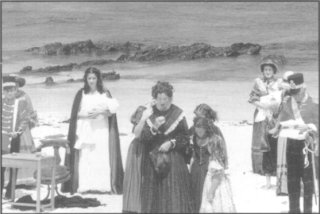
Birkenhead tableau, Stanford's Cove.
The women describe the terrible journey.
The costumes were made by Mrs Corrie Riddering (centre).
(Photo: By courtesy, A Gordon).
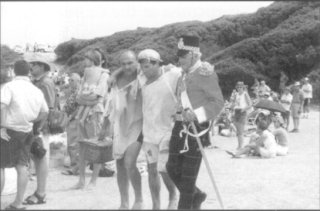
The Birkenhead tableau, Stanford's Cove. Here,
'Captain Wright' and other 'survivors' assist
'Ensign Lucas'. (Photo: By courtesy, A Gordon).
A commemorative service was held at the Chapel of the Royal Hospital, Chelsea, London, on Sunday, 24 February. Wreaths were laid by all services and regiments at the large monument erected on the orders of Queen Victoria.
At Danger Point on 26 February, the actual date of the anniversary, a memorial service was held, and the Birkenhead Memorial was rededicated. A new metal plaque was affixed. Five serving British officers attended the ceremony.
A video of the ceremonies is available. Phone Simon on
+27(021) 761 1810. There is also a comprehensive web site:
www.overberg.co.za/Birkenhead
On the 26 February 1852 the British Troopship Birkenhead carrying reinforcements to the Kaffir Wars struck an unchartered rock two miles off shore at Danger Point. She sank in twenty minutes. To enable the cutters containing the women and children to escape to safety, two hundred frightened and dishevelled soldiers stood to attention as the ship went down into shark infested waters. From this incredible act of courage was born the time honoured tradition of "women and children first" in times of peril.
Under the command of Lt. Col. Alexander Seton, detachments from three Scottish and seven English regiments were on board, together with families and the crew. There were 643 souls in total, of which 436 died and 207 survived. There was also a kings ransom in gold coins on board which, over the years, has brought diving teams to the scene from England and South Africa.
The book Stand Fast by David Bevan contains illustrated chapters on the voyage down to the Cape, the disaster itself, the subsequent Courts Marshall, lists of troops with regimental numbers, and a chapter devoted to the 10 'Birkenhead Regiments'.
To find out more about and/or order the book, use this link:
Return to Journal Index OR Society's Home page
South African Military History Society / scribe@samilitaryhistory.org